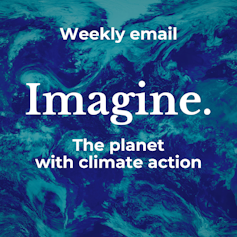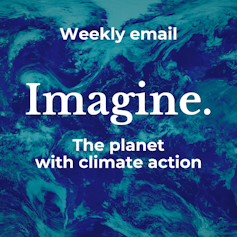Alones/Shutterstock" src="https://s.yimg.com/ny/api/res/1.2/oPCShDY4qGvCxoygPiYz0Q-/YXBwaWQ9aGlnaGxhbmRlcjt3PTk2MDtoPTY0MQ-/https://media.zenfs.com/en/the_conversation_464/67410acff3c7da640e 7b724e0a007a4c" data-src= "https://s.yimg.com/ny/api/res/1.2/oPCShDY4qGvCxoygPiYz0Q-/YXBwaWQ9aGlnaGxhbmRlcjt3PTk2MDtoPTY0MQ-/https://media.zenfs.com/en/the_conversation_464/67410acff3c7da640e7b724e 0a007a4c"/>
A hotter world will probably be a sicker world.
The increasing fever on earth has obvious consequences for human health, such as heat waves that are hotter than our physiology can tolerate. However, humanity's departure from the stable climate it inherited will also bring surprises. Some of these may be existing diseases appearing in new places or spreading with greater ferocity. And some, experts fear, could be entirely new diseases.


The mosquito-borne malaria infection has killed more than half a million people annually over the past decade. Most of these victims were children and almost all (95% in 2022) were in Africa.
As a source of disease, contagious mosquitoes are at least predictable in their need for three things: warm temperatures, moist air, and puddles in which to breed. So what difference will global warming make?
Parasites are on the rise
"The relationship between climate and malaria transmission is complex and has been the subject of intensive research for around thirty years," say water and health experts Mark Smith (University of Leeds) and Chris Thomas (University of Lincoln).
Read more: Mapping malaria in Africa: Climate change research predicts where mosquitoes will breed in the futureMuch of this research has focused on sub-Saharan Africa, the global epicenter of malaria cases and deaths. Smith and Thomas combined temperature and water movement projections to create a continent-wide analysis of malaria risk.
Their results showed that conditions for malaria transmission will generally become less suitable, especially in West Africa. But where temperature and humidity are likely to be favorable to infectious mosquitoes in the future, many more people are expected to live near rivers such as the Nile in Egypt.
"This means that the number of people living in potentially malaria-endemic areas (those open to transmission for more than nine months of the year) will increase to more than a billion by 2100," they say.
Elsewhere, tropical diseases will lose their links if the insects that carry them survive further from the equator. This is already happening in France, where dengue cases peaked during the hot summer of 2022.
"It looks like the lowlands of Veneto [in Italy] is emerging as an ideal habitat for the Culex mosquitoes, which can harbor and transmit West Nile virus," said Michael Head, a senior research fellow in global health at the University of Southampton.
Read more: Dengue in France: tropical diseases in Europe may not be so rare for much longerResearch shows that global transmission of mosquito-borne diseases such as malaria and dengue will change, says Mark Booth, senior lecturer in parasite epidemiology at the University of Newcastle. That's the clearest picture Booth could paint by modeling more than two dozen tropical diseases in a warming world.
"For most other parasites there was little or no evidence. We simply don't know what to expect," he says.
Read more: Why climate change is making parasitic diseases harder to predictSome diseases will bring new torments to the species humans breed. Bluetongue, a virus transmitted by mosquitoes, is expected to infect sheep further afield - in central Africa, western Russia and the U.S. - than in subtropical Asia and Africa, where it evolved, Booth says.
And the prognosis for some diseases that affect humans will worsen. UCL academics Sanjay Sisodiya, a neuroscientist, and Mark Maslin, an Earth system scientist, found that climate change worsens the symptoms of certain brain disorders.
Read more: Climate change linked to worsening brain diseases - new study"Each of the billions of neurons in our brain is like a learning, adapting computer, with many electrically active components," they say. "Many of these components operate at different rates depending on the ambient temperature, and are designed to work together within a narrow temperature range."
It is a species that evolved in Africa. People feel comfortable between 20 and 26 degrees Celsius and indoor humidity of 20 to 80 percent, Sisodiya and Maslin say. Our brains are already working close to the limit of the desired temperature range in most cases, so even small increases matter.
"When these environmental conditions quickly move to unusual levels, as happens with extreme temperatures and humidity associated with climate change, our brains have difficulty regulating our temperature and begin to function poorly."
One planet, one health
Clearly, staying healthy isn't as simple as regulating what you eat or how often you exercise. There is much that is beyond your direct control.
"Within less than three years, the World Health Organization (WHO) declared two public health emergencies of international concern: COVID-19 in February 2020 and monkeypox in July 2022," said Arindam Basu, associate professor of epidemiology and environmental health at the University of Canterbury.
"At the same time, extreme weather events are continuously being reported around the world and are expected to become more frequent and intense. These are not separate issues."
Basu emphasizes the danger of new diseases emerging, especially from pathogens that can jump between humans and animals as habitats change due to global warming.
Read more: One Health: why we need to combine disease surveillance and climate modeling to prevent future pandemics"Close contact between people and wildlife is increasing as forests are destroyed to make way for agriculture and the exotic animal trade continues," he says. "At the same time, thawing permafrost releases microbes hidden beneath the ice."
Because pathogens share the same ecosystems as the people and animals they infect, a new understanding of health is urgently needed. This should be aimed at optimizing the health of people, wildlife and the environment, Basu says.
Diseases. Once again, the climate crisis is exposing our countless connections to everything else - and our shared vulnerability on the only planet known to support life.
This article is republished from The Conversation under a Creative Commons license. Read the original article.


